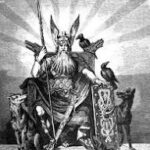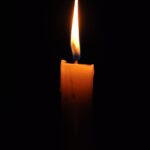A recent posting on social media described a “healthy” way to inform children about the mystery around Santa. A friend of mine responded to the post by sharing what her daughter felt when she was old enough to learn the “truth” of that mystery, and the new traditions they created for themselves thereafter.
As I thought about how anxious and disconnected I’ve felt about the approaching Christmas holiday with its overwhelming commercialism, and as I have been recently redefining what religious or spiritual beliefs I now cherish, I suddenly realized I truly don’t want to celebrate the season the way I’ve seen it come to be or the way I’ve always done it… just because that’s the way I’ve always done it. At the same time, I write this for our children and grandchildren, not so much to make a big announcement, but to free them from any religious traditions I may have insisted on teaching them that raises the question: Why am I doing this?
To move away from the Christian influence of this particular holiday is a monumental undertaking. Even the word “Christmas” implies religious and biblical overtones; there’s nothing hidden in its meaning. But what if you’re not Christian? What if the meaning of the word and the beliefs behind the symbolisms don’t apply to your beliefs? What do you do then?
BACKSTORY
A Christian school provided my early education. Along with my parents, the school presented religious traditions, songs, lessons, stories, and definitions to live a good and moral life. By my mid-teens I was done with the lectures and discipline. However, in my early 30s, I gave it another chance, wondering if those childhood lessons had evolved into something I could relate to and share with my children. It didn’t work out. For nearly another decade I searched for a spiritual path that fit my concept of God.
Eventually, I found New Thought, in particular, Religious Science. Founded as a philosophy in the early 20th century via a textbook written by Ernest Holmes, and in part, based on biblical teachings of Jesus, it was a fresh, yet familiar, concept of how I thought about God. As I delved into the study of this modern religion, I learned that the teachings were based on Universal Principles found common in many of the world’s major religions and great philosophies. It encourages its students to remain “open at the top” and to explore those other religions and their teachings, as well as to test the Universal Principles introduced (to me) in the pages of Holmes’ books. I’ve been studying and testing this philosophy for 30 years. I am still “open” and still learning. Religious Science (AKA Science of Mind) has been my spiritual foundation AND has given me wings to explore.
As a spiritual teacher and ordained minister, it has been my practice to push students past their comfort zones. To help them define their beliefs. To guide them to grow stronger, spiritually. To require them to test the Principles for themselves. To help them deepen their faith and question what it is they truly believe. Lately I’ve been doing the same about Religious Science as I once did about my Christian upbringing. The result of this questioning and exploration has brought me to an intersection of sorts.
HISTORY
Because Religious Science was founded in part on biblical teachings, many of its holiday traditions and rituals “borrow” from those of Christian influences, especially Christmas. The story of the manger is widely repeated in New Thought December church services. While Religious Science is a very contemporary religion, it borrows many of its customs from Christian sources and a few others from other religions. Not many of its rituals or traditions are original or new… and that got me wondering: If I were going to celebrate a holiday in December that recognized and honored the Divine Spirit within me and this amazing world, what would it look like? Could I think of a new way to celebrate? Are there other religions from which I could borrow this or that and create something new?
Since Christians also borrowed a number of practices from the Roman Pagans (Christmas, New Year’s Day, Easter, the Roman version of Halloween, carols, mistletoe, trees, etc.), I did some research of mythology that dated prior to and shortly after Christianity began, and discovered some interesting details:
- “Yule” is the term used for the winter festival observed by the Germanic peoples and eventually incorporated into the Christmas tradition. Yule is considered cultural, while Christmas is (or was) thought of as religious. Yule is a time of celebrating nature and seasonal change.
- Like Winter Solstice, Yule is about celebrating the “return of the sun,” so candles are a big part of its symbolism. Red, green, and gold are considered Yule colors.
- Evergreens are said to represent everlasting life. Evergreens made into a wreath represent the Wheel of Life. Evergreens were hung throughout the home and the lighted wreaths eventually came to represent the Christian Advent wreath.
- Although it apparently took until the Victorian era for German Prince Albert to introduce the Yule tree, it is now simply known as a Christmas tree. Other cultures, such as ancient Rome’s Saturnalia traditions, decorated trees for their Winter Solstice festival to celebrate the light. In Pagan families, they placed a live tree in the home, so the wood spirits kept warm in the cold winter months. It was also commonplace to hang food and treats on the branches for the spirits to eat.

- Odin, the all-father god in Norse mythology, was widely revered in Germanic paganism. Odin appears as a prominent god throughout the recorded history of Northern Europe, from the Roman occupation of regions of Germania (from 2 BCE) through movement of peoples during the Migration Period (4th to 6th centuries CE) and the Viking Age (8th to 11th centuries CE). [Wikipedia.org, 12/4/23]
- While Odin was quite involved in war-like activities, he was also known for keeping tabs on who was “good” or “bad,” bringing gifts to the poor and to children, riding an eight-legged horse, and collecting information from around the world via ravens and wolves.
Sound familiar?
While more information can be found on Odin and various Christian rituals or traditions, beginning around 300-600 CE, the point I want to make here is that we’re making it all up!
Humankind has evolved in its religious beliefs, holiday traditions, and ceremonial rituals primarily through “borrowing” bits and pieces from other cultures, religions, or conquered peoples. We take something, put our own slant on it, and call it ours.
When I was a full-time Religious Science minister, I did the same for our services and celebrations. If I knew (or could find out) where a particular practice or ritual came from, I would give credit to that person or culture or religion, and share as much of the history as I could with those present. However, because Christmas is so engrained in our American culture, I never thought twice about having to explore or explain its origins… until now.
LOOKING FORWARD
This change in thinking is partly due to my increasing focus on Interfaith studies. I want to learn more thoroughly about the common Universal Principles between the world’s major religions, as Holmes taught. I want to focus on a deeper Spirituality, not just religious rules or holy texts. I want to celebrate the return of the sun, the return of the Divine Light within me, and within each living being. And I want this seasonal acknowledgement to be accompanied by physical practices or rituals or traditions that provide heart-felt meaning to me and those who might share it with me.
I’m confident there are bits and pieces I can “borrow” from any of the thousands of religions and practices that more accurately describe my current view of God and how I choose to celebrate each season of life, each month of the year, different from the way I’ve been doing it for the past few decades. I don’t need to stay stuck in a tradition that more often brings me mostly anxiety and pressure, and to which I no longer have connection.
I already know there will be gifts for those I love and cherish, some will be handmade. I want to have candles and incense and evergreens, including a live tree (with solar-powered lights) that I can plant in the spring. Food. Silence. Songs. Laughter. Donations to those struggling. Prayer and meditation, and gratitude for life’s continuing abundance. I think Winter Solstice is a good day to express all this and more.
(with solar-powered lights) that I can plant in the spring. Food. Silence. Songs. Laughter. Donations to those struggling. Prayer and meditation, and gratitude for life’s continuing abundance. I think Winter Solstice is a good day to express all this and more.
It’ll be interesting to see how it unfolds and evolves over time. I get to choose what serves my soul, my heart, my home… just as you get to choose for you and yours.